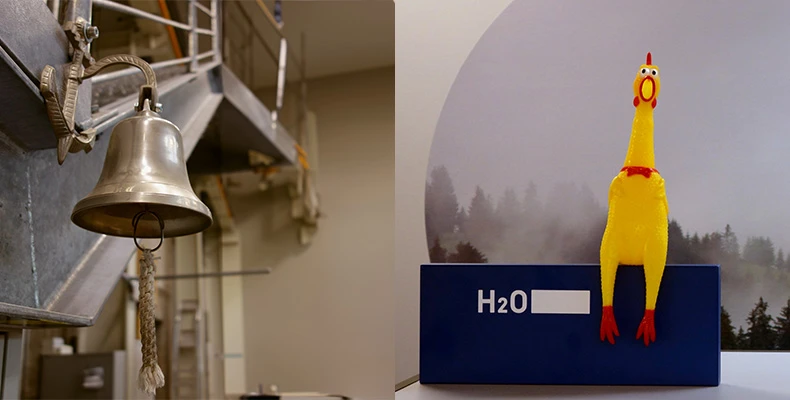Contact us
25 years of H2O - today we are not only looking back on a quarter of a century of company history, but also on an exciting journey full of technological advances – of which we sometimes have to smile about ourselves. Our design manager Andreas Strübe has been with us almost since the beginning. Here he ponders about what design and production looked like 25 years ago, why we had our own stalactite cave and why Polaroids were so important to us.
A little quiz to start our journey through time! Guess:
Did you go for 1? Wrong... 25 years ago there were still some professions and companies that still drew on paper, but not at H2O.
You thought maybe 3? No... unfortunately not. We weren't that far ahead of our time. But thank you for giving us the credit!
2? That's right! Of course, also digital drawing in 2D presented exciting challenges. "There were so many overlapping lines in the flat view that it was difficult to see all the possible collision points. And we only knew whether there was room for all the pipework in the machine after the prototype had been built eventually," says Head of Design Andreas Strübe.
Three all-round talents designed the systems back then - today there are nine. The VACUDEST went into series production only, once the prototypes had been built and all the necessary adjustments had been made. "Of course, the systems were much smaller back then, our largest system processed 400 litres per hour - today we process up to 5,000 litres per hour. That's why our production was also much smaller. Back then, two employees manufactured the systems. Byheart from the top of their heads!And sometimes with the help of Polaroid photos as manufacturing instructions." In comparison, today 14 people work in a LEAN production environment with state-of-the-art equipment.
And the stalactite cave? Andreas smiles. "We put every system through its paces before it leaves the company for the customer. That was the case back then, and it's still the case today. We have a separate room for this - the technical centre. Back then, this technical centre was not a metre-high experimental hall like today, but a makeshift wooden shed. Since it very quickly became too small for the growing company, the roof of this shed was used as an extension for the water tanks. And because things can go wrong during test runs and tanks at the top sometimes overflew, we affectionately called the wooden shed underneath it the "dripstone cave".

Andreas has also fond memories of the good old days: "25 years ago, the work was entirely different: you had a broader approachof tasks, you designed, built, wired control cabinets, carried out test runs and commissioned on site. Today, you have to be much more specialised in your area in order to be able to handle the increasingly complex projects.
The H2O family was small and fine, the founding spirit was clearly noticeable. After 25 years, our H2O family has grown considerably. To over 130 employees worldwide right now. But our vision and our commitment to the environment remain unshakableen. H2O's DNA hasn't changed, we've just found more people who share it.
| Back then | Today |
|
Largest system: 400 litres per hour |
Largest system: 5,000 litres per hour |
| Text-based control - improved calculator |
Graphic touch control with targeted safety messages and remote access
|
| Inaccurate error messages takea lot of time to resolve, service technicians had to write down error messages on site | Precise safety messages are transmitted digitally and resolved remotely in 8 out of 10 cases without a service technician having to make the journey. |
|
Technical design in 2D drawings |
3D - CAD design |
|
A few technologies for improving distillate quality positioned outside of the system |
Space-saving all-in-one box: Integrated technologies for the highest possible quality on the smallest possible footprint
|
|
3 all-round talents in system design, 2 Allrounders in production |
9 experts in system design, 14 specialists in production
|
|
Electrical power was in short supply - dishwashers and coffee machines had to be unplugged during test runs of large systems. To be on the safe side, data were also backed up on the PCs. |
Plenty of power at the site, also thanks to our own photovoltaic system on the roof of the production facility. |
|
Order announcement with a loud order bell that could be heard throughout the company. |
Order announcement with an informative and entertaining newsletter and the loud crowing of our rubber order chicken. |
You have questions on our VACUDEST systems?
Kindly contact us!
Your contact is:
Thomas Dotterweich
Senior Sales Engineer
+49 7627 9239-306
thomasm.dotterweich@h2o-de.com
You need consumables, spare parts or a maintenance date?
We will be pleased to assist you!
Your contact is:
Carles Fité
Technical Customer Support
+49 7627 9239-888
carles.fite@h2o-de.com
You want to be part of our team and create the wastewater-free future with us?
We will tell you how!
Your contact is:
Bettina Böhringer
Human Resources
+49 7627 9239-201
career@h2o-de.com